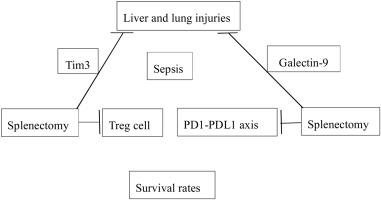The International Journal of Biochemistry & Cell Biology ( IF 3.4 ) Pub Date : 2021-03-24 , DOI: 10.1016/j.biocel.2021.105970 Haiyan Chen 1 , Na Huang 1 , Hongwei Tian 2 , Jun Li 2 , Baohua Li 1 , Jin Sun 2 , Shaoying Zhang 2 , Chen Zhang 2 , Yang Zhao 2 , Guangyao Kong 3 , Zongfang Li 3

|
The role of the spleen in sepsis is still controversial. Therefore, we investigated the effect of the spleen on sepsis-induced immune dysfunction in C57BL/6 mice subjected to caecal ligation and puncture (CLP). Changes in different immune cells and apoptotic cells in the spleen and peripheral blood were observed 4, 24 and 48 h after CLP. Then, we determined that 48 h following CLP was the most significant period of immunosuppression. Next, we divided the mice into four groups: control, CLP, CLP + spx (splenectomy 48 h after CLP) and spx + CLP (splenectomy surgery two weeks before CLP). Compared with the CLP mice, the CLP + spx and spx + CLP mice had improved survival rates and organ injuries, increased expression of inflammatory factors, a decreased proportion of regulatory T cells (Tregs), and reduced expression of the genes involved in the programmed cell death 1 and its ligand 1 (PD1-PDL1) pathway in immune cells and T-cell immunoglobulin-mucin domain 3 (Tim 3) and Galectin9 in the liver and lungs after 72 h in late-phase sepsis. In addition, the expression of PD-1 was significantly reduced in T cells in spx + CLP mice, and the expression of PD-L1 in myeloid-derived suppressor cells (MDSCs) was reduced in the CLP + spx group, especially in macrophages. These findings suggested that splenectomy could protect septic mice from exhaustion of immune cells by reducing the proliferation of Treg cells and expression of the PD-1/PD-L1 axis in immune cells during the immunosuppressive stage of sepsis. Splenectomy could also reduce liver and lung injuries possibly via the Tim 3 and/or Galectin-9 axis. The spleen is an important regulator of the occurrence and development of sepsis, which provides a new perspective to improve the prognosis of sepsis by regulating the spleen.
中文翻译:

脾切除术通过减少 TRegs 和 PD-1/PD-L1 表达,对 CLP 诱导的败血症提供保护作用
脾在脓毒症中的作用仍存在争议。因此,我们研究了脾脏对接受盲肠结扎和穿刺 (CLP) 的 C57BL/6 小鼠败血症诱导的免疫功能障碍的影响。在CLP后4、24和48小时观察脾脏和外周血中不同免疫细胞和凋亡细胞的变化。然后,我们确定 CLP 后 48 小时是免疫抑制的最重要时期。接下来,我们将小鼠分为四组:对照、CLP、CLP + spx(CLP 后 48 小时脾切除术)和 spx + CLP(CLP 前两周脾切除术)。与 CLP 小鼠相比,CLP + spx 和 spx + CLP 小鼠的存活率和器官损伤有所提高,炎症因子的表达增加,调节性 T 细胞 (Tregs) 的比例降低,72 小时后,免疫细胞中参与程序性细胞死亡 1 及其配体 1 (PD1-PDL1) 通路的基因和肝脏和肺中 T 细胞免疫球蛋白-粘蛋白结构域 3 (Tim 3) 和 Galectin9 的表达降低晚期败血症。此外,spx+CLP小鼠T细胞中PD-1的表达显着降低,CLP+spx组骨髓源性抑制细胞(MDSCs)中PD-L1的表达降低,尤其是在巨噬细胞中。这些发现表明,脾切除术可以通过减少脓毒症免疫抑制阶段 Treg 细胞的增殖和免疫细胞中 PD-1/PD-L1 轴的表达来保护脓毒症小鼠免受免疫细胞衰竭。脾切除术还可能通过 Tim 3 和/或 Galectin-9 轴减少肝和肺损伤。









































 京公网安备 11010802027423号
京公网安备 11010802027423号